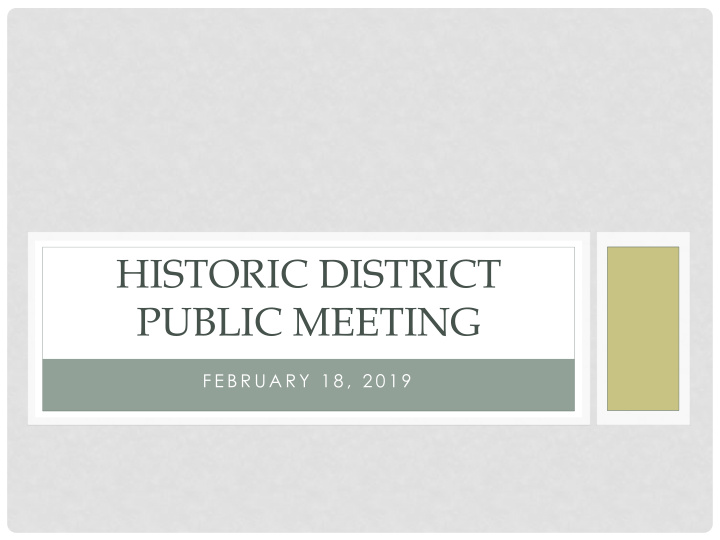



HISTORIC DISTRICT PUBLIC MEETING F E B R U A R Y 1 8 , 2 0 1 9
WHAT IS THE NATIONAL REGISTER OF HISTORIC PLACES? • The National Register is maintained by the National Park Service and was created in 1966 as a way to identify and encourage the preservation of our nation’s historic places
WHAT IS A NATIONAL REGISTER HISTORIC DISTRICT? • A concentration of historic buildings, structures, sites and/or objects united historically or aesthetically by plan or physical development.
WHY NOMINATE A DISTRICT TO THE NATIONAL REGISTER? • An area may have a concentration of historic resources that are eligible for listing • Listing the resources as a collection, rather than individually, streamlines the process and is more inclusive • Some properties may not be eligible on their own but contribute to the district as a whole
HOW ARE BOUNDARIES DRAWN FOR HISTORIC DISTRICTS? • Boundaries for historic districts are typically drawn to include a significant concentration of historic properties of a similar type, such as commercial and public buildings in a downtown or a neighborhood of residences • Most districts include some properties that are non- historic or have been significantly altered
WHAT IS A CONTRIBUTING RESOURCE? • A building, structure, object or site with the boundaries of a the district that adds to the historic quality and significance of the district. • Contributing resources may be eligible for financial incentives
WHAT IS A NON-CONTRIBUTING RESOURCE? • Resources that don’t contribute to the significance of the district • May be less than 50 years old (or may not fit the time period of the district) • May have been significantly altered so that their new appearance is no longer historic • Not eligible for financial incentives
WHO DETERMINES THE CONTRIBUTING/ NON-CONTRIBUTING STATUS OF A RESOURCE? • State Historic Preservation Office (SHPO) • Status can change over time if alterations are made to the resource
FINANCIAL INCENTIVES • Heritage Trust Fund Grant Program • Competitive grants funding of approx $1 million in Kansas • An applicant can receive from $5,000-$90,000 with match • Eligible work includes building components including mechanical, plumbing and electrical. However, projects involving the structure itself are generally more competitive • State & Federal Rehabilitation Tax Credits • Income tax credit • Federal-20% of qualifying expenses (only income producing properties) • State-25% of qualifying expenses or 30% for qualifying 501(c)3 organizations (all properties) Credits can be sold •
IS THERE AN OPPORTUNITY FOR PUBLIC INPUT ON A NOMINATION? • Local discussion is encouraged (this meeting) • When a nomination is finalized the Kansas Historic Sites Board of Review meets and determines if the majority of owners do not object. This board will notify all property owners in advance of the meeting to determine if there are any objections.
CAN OWNERS WHO OBJECT KEEP THEIR PROPERTIES OUT OF THE DISTRICT? • No. The entire district can be listed if a majority of the owners do not object to the nomination.
MYTHS AND MISCONCEPTIONS • Myth: “If my property is listed in the National Register, I won’t be able to change it in any way, and I don’t want my property to become like a museum.” • Fact: Owners of registered properties may make changes to their properties. Preservation laws and guidelines are not meant to prevent change, but, rather to sensitively manage change
MYTH #2 • Myth: “If my property is listed in the National Register, small projects will become cumbersome because they must be approved by the State Historic Preservation Office.” • Fact: The State Historic Preservation Office only reviews projects that require local permits and projects that involve government funding. AND in our case the City has an agreement in which these reviews are conducted by the Historic Preservation Board under the guidance of the SHPO.
MYTH #3 • Myth: “If a property is listed on the National Register, it will be protected forever and never be demolished.” • Fact: National Register designation ensures a more thorough review of major projects and demolitions, but it does not prohibit demolition. If it is determined that the demolition will adversely effect the historic property, the owner has the opportunity to appeal to the city commission and demonstrate that there are no feasible alternatives.
MYTH #4 • Myth: “If my property is listed in the National Register, there’s lots of government money available to help me fix it up.” • Fact: While there are a few options available to help (grants and tax credits), this should not be relied on for total project financing.
MYTH #5 • Myth: “I will be required to make my property available to the public if it is listed in the National Register.” • Fact: Hundreds of private properties in Kansas are listed on the National Register and the majority are not open to the general public. Some have been open as museums but this is not required.
FURTHER INFO • Websites: • Kansas Historical Society www.kshs.org • National Park Service www.nps.gov • National Register of Historic Places https://www.nps.gov/subjects/nationalregister/index.htm • National Trust for Historic Preservation www.preservationnation.org • Kansas Historic Resources Inventory www.kshs.org/khri
CONTACTS • State Historic Preservation Office • kshs.shpo@ks.gov 785-272-8681 ext 240 • Patrick Zollner, Deputy SHPO • Patrick.zollner@ks.gov • Katrina Ringler, Grants Manager • Katrina.ringler@ks.gov • Jamee Fiore, National Register/Survey Coordinator • Jamee.fiore@ks.gov • Kristen Johnston/Bethany Emenhiser, Tax Credits • Kristen.johnston@ks.gov • Bethany.emenhiser@ks.gov • Lauren Jones, Review and Compliance • Lauren.jones@ks.gov
QUESTIONS/ANSWERS • Josh White, Principal Planner • Neighborhood Services, 2 nd Floor City Hall • 620-441-4420 • jwhite@arkansascityks.gov • This presentation will be available on the city website
Recommend
More recommend